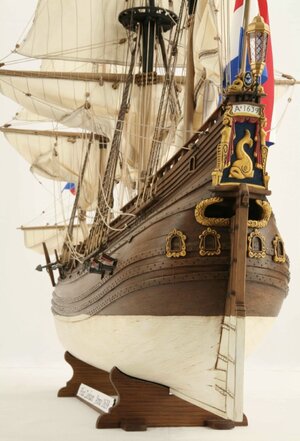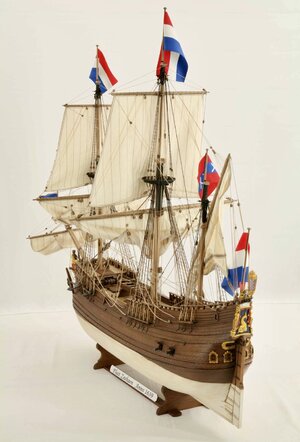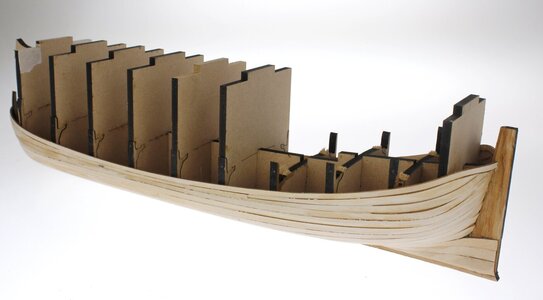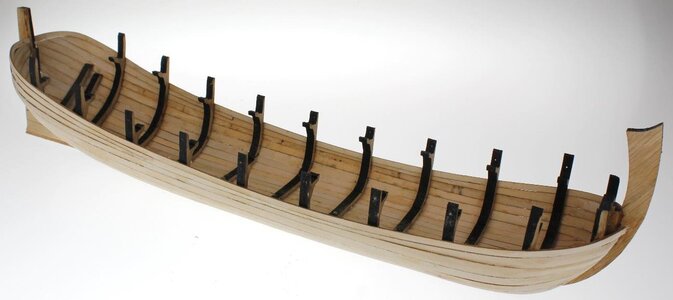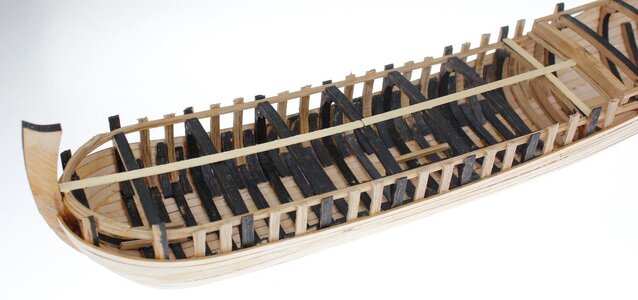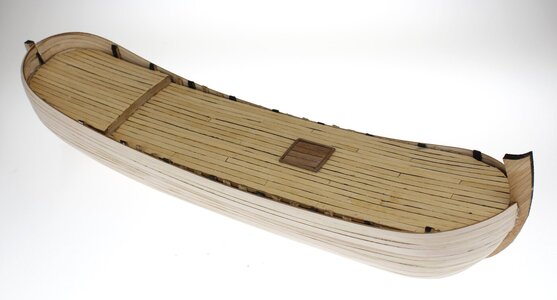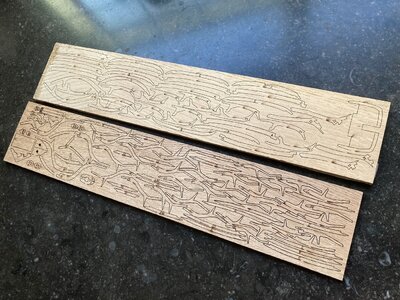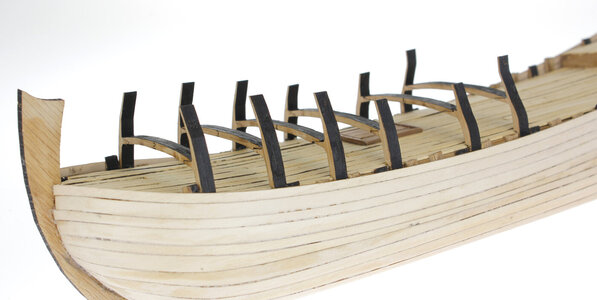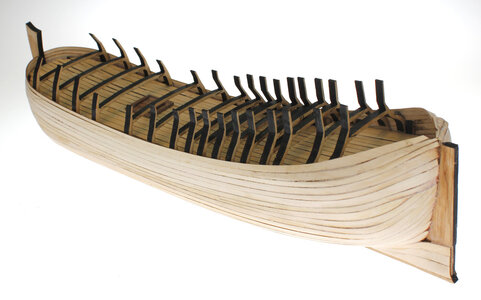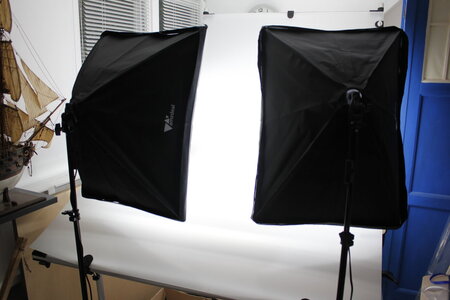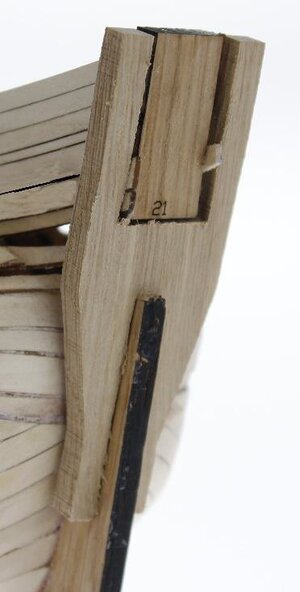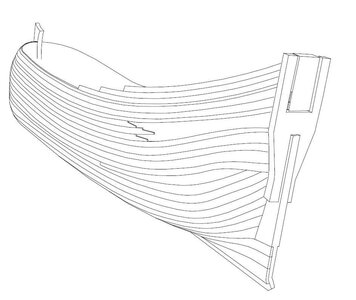This is my introduction of a new kit we (=Kolderstok) have developped in the last two years. It is a 17th century Fluytschip, or Fluit.
When you translate Fluit into English you get flute. Where the name fluit is derived from is not really known, but in general you can say that the shape of the ship - long, narrow and straight over almost her full length very much looks like a flute.
The Fluit was the cargo ship in the Dutch replublic in the 17th century, and without it there would not have been that much wealth to the Dutch merchants.
A short explanation regarding the development of this new kit (this is also the introduction given in the building instructions):
In the course of the 16th century, the importance of the Republic of the Netherlands as a seafaring nation grew. Dutch ships and their owners were present on a large part of the seas, and the Netherlands had a strong presence in the Baltic Sea area as well. This solid position was largely achieved through the so called “moedernegotie”, the mother of all trade.
This trade focused mainly on the countries around the Baltic Sea, initiated by merchants from Amsterdam. It quickly became a major - if not the major - source of income. Amsterdam thus became the economic centre and the most important warehouse in Europe. The highly profitable trade around the Baltic Sea laid a solid foundation for the prosperity and blossoming of the Dutch Republic in the 17th century. The favourable location of Amsterdam, at the Zuiderzee with direct connection to the North Sea and via the Sont to the Baltic, brought great wealth to the Amsterdam merchants. The trade mainly focused on bulk goods such as grain and wood, wine and salt. Loaded with products from Europe, the ships sailed to
Poland, the Scandinavian countries, East Prussia and Russia and then returned with important goods such as grain, animal skins, iron and wood, whereby the wood and grain were of particular importance. The wood was sawn in Zaandam to be used for building ships and the grain was stored in the staple market of Amsterdam to be sold on in times of scarcity in Europe - at a hefty profit, of course. These profits were later reinvested in shipping to the East Indies. But: there can be no trade without good cargo ships.
The Low Countries already had a very strong reputation when it came to shipbuilding, and in Hoorn it was the merchant Pieter Jansz. Liorne who managed to develop an existing type of ship into an ideal cargo ship. Long and spacious, easy to load and easy to sail with only a small crew, even in shallow water. This shipwas the Flute ship, or flute for short.
The first written mention of the flute ship dates from the year 1604. In the Chronijk van de stadt van Hooren (Chronicle of the city of Hoorn) by Theodorus Velius (pseudonym of Dirk Seylmaecker) he talks about the situation in Hoorn in 1595:
This very year the boats, that one calls Hoornish goings or flutes, were first made here, being (...)
very suitable for sea sailing, both for the sailing to the wind, as for the shallow way of sailing; so
much are they wanted, that in 8 years time 80 such boats have been outfitted here in Hoorn to the
great benefit of the citizens.
Liorne is often mentioned as the inventor of the flute ship, but it is more likely that he was an advocate of a ship that had already been created and was further developed by him. Whereas the first ships had a length to width ratio of 3 to 3.5 to 1, with a narrow bow and stern and a relatively wide middle span, the Baptist Liorne actively argued for longer ships with a length to width ratio of 4 to 1, 5 to 1 and even 6 to 1, as also described in the bible for Noah's Ark, 300 cubits long and 50 cubits wide. At first he was mocked for these long, narrow ships, but soon other shipbuilders had to recognise that of all the ships, these were the most suitable for trading in peacetime, as they could carry up to a third more cargo and still be sailed with no more crew. The fact that the specific pear-shaped hull was less suitable for arming was not an objection for the mostly Baptist shipowners and crew, since they were opposed to
violence on the basis of their religious doctrine. When the twelve-year armistice ended in 1621, the call to arms returned and the ships became shorter again. However, many ships remained unarmed.
The flute ship was so successful that the builders in the Zaan region simply built their ships at their own risk and only sold them when a buyer came along. And buyers usually came quickly enough. If they did not, the builders chartered out the ships at their own risk as whalers until a buyer came forward, after which the ship was fitted out according to the wishes of the new owner and started a second career. The ships were constantly adapted and changed to meet the wishes and requirements of owner and cargo. They were workhorses, they were battered and abused and often looked like it. The typical pear-shaped hull was not – as often said – intended to avoid tolls in the Sound. The system of toll collection was set up in such a way that a skipper paid according to the cargo he was carrying, which he also had to declare in detail when passing through the Sound. The toll collectors kept meticulous records of
this in their books, so meticulous that any discrepancies in the ship's carrying capacity could lead to retrospective levies on previous passages. The toll collectors did not allow themselves to be fooled by the width of a deck. The narrow decks were intended to make it possible to build the ship at lower cost and to reduce walking distances on the ship. The latter had the great advantage that the ship could be sailed with only 12 crew members.
This building kit of the flute ship is partly due to the work of Ab Hoving and René Hendrickx. Hoving has elaborated the 17th century specifications of a flute ship written by Nicolaes Witsen into usable documents, and Hendrickx has made this into a computer model using the Delftship programme: Using this computer model, Kolderstok was able to make a copy of the important parts of the ship: the keel, the various frames and the shape of the skin planking. Especially the latter is an important aspect of the model. In most cases, wooden ship kits consist of a keel, frames and straight planks with which the hull planking is ultimately formed. However, this does not correspond to how 17th century Dutch ships were built. Each plank, starting from the first one at the keel to the last plank of the railing, had its own shape, and was made to fit the hull on the spot with the help of fire and forced deformation. Each plank was different from the previous one. This was particularly important for a ship like the Flute. The blunt bow and the round, full stern cannot be covered (or only with great difficulty) with straight planks in the usual (and not historically correct) way. But even with planks cut in the right shape, it is a challenge to get the hull planked properly. Thanks to some useful tips from Hoving, a method with an auxiliary frame was developed for this purpose, whereby the hull is planked up to the third wale, and the upper railing and wales are fitted using this auxiliary frame. Then the rounded back between the bilge and the upper railing can be cut to size and fitted. It can still happen that a plank breaks or splits during bending and placing, so these tricky planks have been doubled up as reserves in the box. The construction of the model is largely done in the same way as the Dutch ships used to be built. A keel is placed on which the frames are placed in the correct shape with the aid of an auxiliary jig. Then, starting at the keel with the garboard strake, the hull is planked upwards. Since the model is upside down at this stage, the planking then effectively goes down. After a number of hull planks have been placed, the auxiliary frames are broken out of the model and a completely hollow hull is formed. This is gradually built further upwards until the complete hull is made. This method of construction offers the possibility to make the model (partly) open according to one's own insight and ideas. However, this is not included in the standard package.
Another possibility is to individualise the model by placing different stern ornaments. There is also the possibility to make different kinds of flute ships. The model is based on a wood-carrier, but with some modifications it can also be equipped as a whaler. The steps for this are mentioned separately in the building instructions.
Finally, one can choose to place an individual flag on the ship in addition to the standard flags. This is also
indicated separately.
In the following posts I will show how the model is built.
Hans van Nieuwkoop
Kolderstok Modelbouw
When you translate Fluit into English you get flute. Where the name fluit is derived from is not really known, but in general you can say that the shape of the ship - long, narrow and straight over almost her full length very much looks like a flute.
The Fluit was the cargo ship in the Dutch replublic in the 17th century, and without it there would not have been that much wealth to the Dutch merchants.
A short explanation regarding the development of this new kit (this is also the introduction given in the building instructions):
In the course of the 16th century, the importance of the Republic of the Netherlands as a seafaring nation grew. Dutch ships and their owners were present on a large part of the seas, and the Netherlands had a strong presence in the Baltic Sea area as well. This solid position was largely achieved through the so called “moedernegotie”, the mother of all trade.
This trade focused mainly on the countries around the Baltic Sea, initiated by merchants from Amsterdam. It quickly became a major - if not the major - source of income. Amsterdam thus became the economic centre and the most important warehouse in Europe. The highly profitable trade around the Baltic Sea laid a solid foundation for the prosperity and blossoming of the Dutch Republic in the 17th century. The favourable location of Amsterdam, at the Zuiderzee with direct connection to the North Sea and via the Sont to the Baltic, brought great wealth to the Amsterdam merchants. The trade mainly focused on bulk goods such as grain and wood, wine and salt. Loaded with products from Europe, the ships sailed to
Poland, the Scandinavian countries, East Prussia and Russia and then returned with important goods such as grain, animal skins, iron and wood, whereby the wood and grain were of particular importance. The wood was sawn in Zaandam to be used for building ships and the grain was stored in the staple market of Amsterdam to be sold on in times of scarcity in Europe - at a hefty profit, of course. These profits were later reinvested in shipping to the East Indies. But: there can be no trade without good cargo ships.
The Low Countries already had a very strong reputation when it came to shipbuilding, and in Hoorn it was the merchant Pieter Jansz. Liorne who managed to develop an existing type of ship into an ideal cargo ship. Long and spacious, easy to load and easy to sail with only a small crew, even in shallow water. This shipwas the Flute ship, or flute for short.
The first written mention of the flute ship dates from the year 1604. In the Chronijk van de stadt van Hooren (Chronicle of the city of Hoorn) by Theodorus Velius (pseudonym of Dirk Seylmaecker) he talks about the situation in Hoorn in 1595:
This very year the boats, that one calls Hoornish goings or flutes, were first made here, being (...)
very suitable for sea sailing, both for the sailing to the wind, as for the shallow way of sailing; so
much are they wanted, that in 8 years time 80 such boats have been outfitted here in Hoorn to the
great benefit of the citizens.
Liorne is often mentioned as the inventor of the flute ship, but it is more likely that he was an advocate of a ship that had already been created and was further developed by him. Whereas the first ships had a length to width ratio of 3 to 3.5 to 1, with a narrow bow and stern and a relatively wide middle span, the Baptist Liorne actively argued for longer ships with a length to width ratio of 4 to 1, 5 to 1 and even 6 to 1, as also described in the bible for Noah's Ark, 300 cubits long and 50 cubits wide. At first he was mocked for these long, narrow ships, but soon other shipbuilders had to recognise that of all the ships, these were the most suitable for trading in peacetime, as they could carry up to a third more cargo and still be sailed with no more crew. The fact that the specific pear-shaped hull was less suitable for arming was not an objection for the mostly Baptist shipowners and crew, since they were opposed to
violence on the basis of their religious doctrine. When the twelve-year armistice ended in 1621, the call to arms returned and the ships became shorter again. However, many ships remained unarmed.
The flute ship was so successful that the builders in the Zaan region simply built their ships at their own risk and only sold them when a buyer came along. And buyers usually came quickly enough. If they did not, the builders chartered out the ships at their own risk as whalers until a buyer came forward, after which the ship was fitted out according to the wishes of the new owner and started a second career. The ships were constantly adapted and changed to meet the wishes and requirements of owner and cargo. They were workhorses, they were battered and abused and often looked like it. The typical pear-shaped hull was not – as often said – intended to avoid tolls in the Sound. The system of toll collection was set up in such a way that a skipper paid according to the cargo he was carrying, which he also had to declare in detail when passing through the Sound. The toll collectors kept meticulous records of
this in their books, so meticulous that any discrepancies in the ship's carrying capacity could lead to retrospective levies on previous passages. The toll collectors did not allow themselves to be fooled by the width of a deck. The narrow decks were intended to make it possible to build the ship at lower cost and to reduce walking distances on the ship. The latter had the great advantage that the ship could be sailed with only 12 crew members.
This building kit of the flute ship is partly due to the work of Ab Hoving and René Hendrickx. Hoving has elaborated the 17th century specifications of a flute ship written by Nicolaes Witsen into usable documents, and Hendrickx has made this into a computer model using the Delftship programme: Using this computer model, Kolderstok was able to make a copy of the important parts of the ship: the keel, the various frames and the shape of the skin planking. Especially the latter is an important aspect of the model. In most cases, wooden ship kits consist of a keel, frames and straight planks with which the hull planking is ultimately formed. However, this does not correspond to how 17th century Dutch ships were built. Each plank, starting from the first one at the keel to the last plank of the railing, had its own shape, and was made to fit the hull on the spot with the help of fire and forced deformation. Each plank was different from the previous one. This was particularly important for a ship like the Flute. The blunt bow and the round, full stern cannot be covered (or only with great difficulty) with straight planks in the usual (and not historically correct) way. But even with planks cut in the right shape, it is a challenge to get the hull planked properly. Thanks to some useful tips from Hoving, a method with an auxiliary frame was developed for this purpose, whereby the hull is planked up to the third wale, and the upper railing and wales are fitted using this auxiliary frame. Then the rounded back between the bilge and the upper railing can be cut to size and fitted. It can still happen that a plank breaks or splits during bending and placing, so these tricky planks have been doubled up as reserves in the box. The construction of the model is largely done in the same way as the Dutch ships used to be built. A keel is placed on which the frames are placed in the correct shape with the aid of an auxiliary jig. Then, starting at the keel with the garboard strake, the hull is planked upwards. Since the model is upside down at this stage, the planking then effectively goes down. After a number of hull planks have been placed, the auxiliary frames are broken out of the model and a completely hollow hull is formed. This is gradually built further upwards until the complete hull is made. This method of construction offers the possibility to make the model (partly) open according to one's own insight and ideas. However, this is not included in the standard package.
Another possibility is to individualise the model by placing different stern ornaments. There is also the possibility to make different kinds of flute ships. The model is based on a wood-carrier, but with some modifications it can also be equipped as a whaler. The steps for this are mentioned separately in the building instructions.
Finally, one can choose to place an individual flag on the ship in addition to the standard flags. This is also
indicated separately.
In the following posts I will show how the model is built.
Hans van Nieuwkoop
Kolderstok Modelbouw


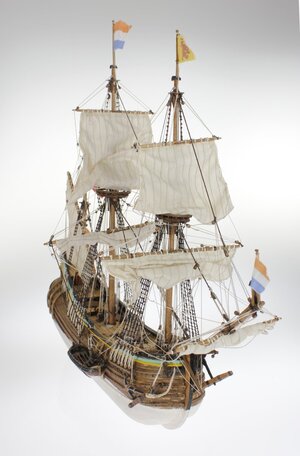
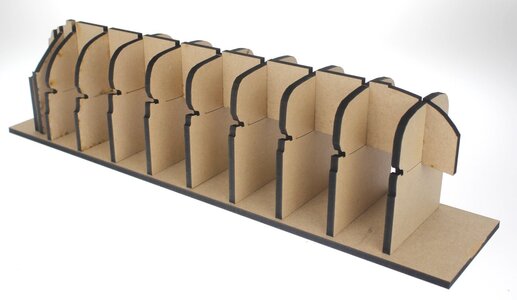
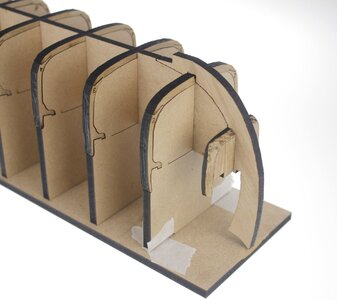
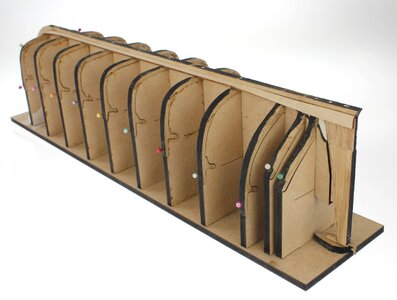
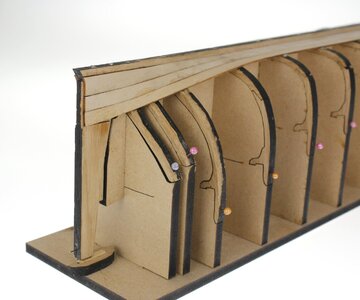
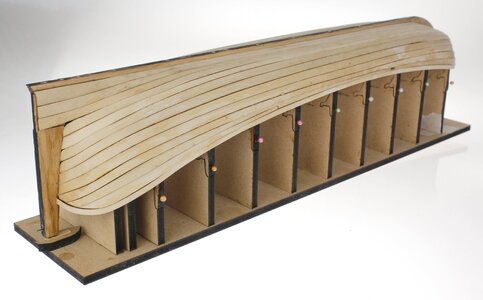

 Will the hull-planking experts stand up please?
Will the hull-planking experts stand up please?

